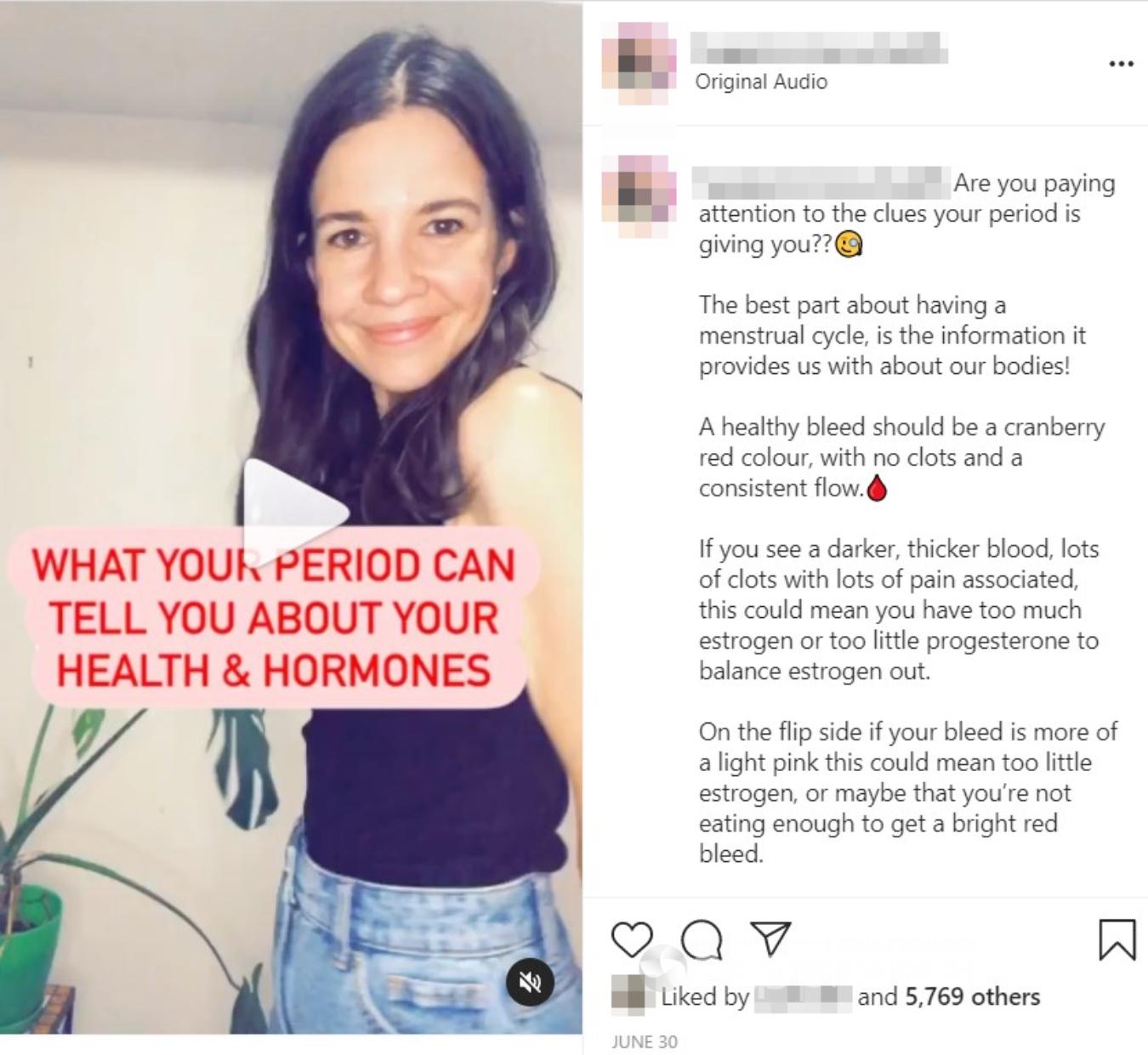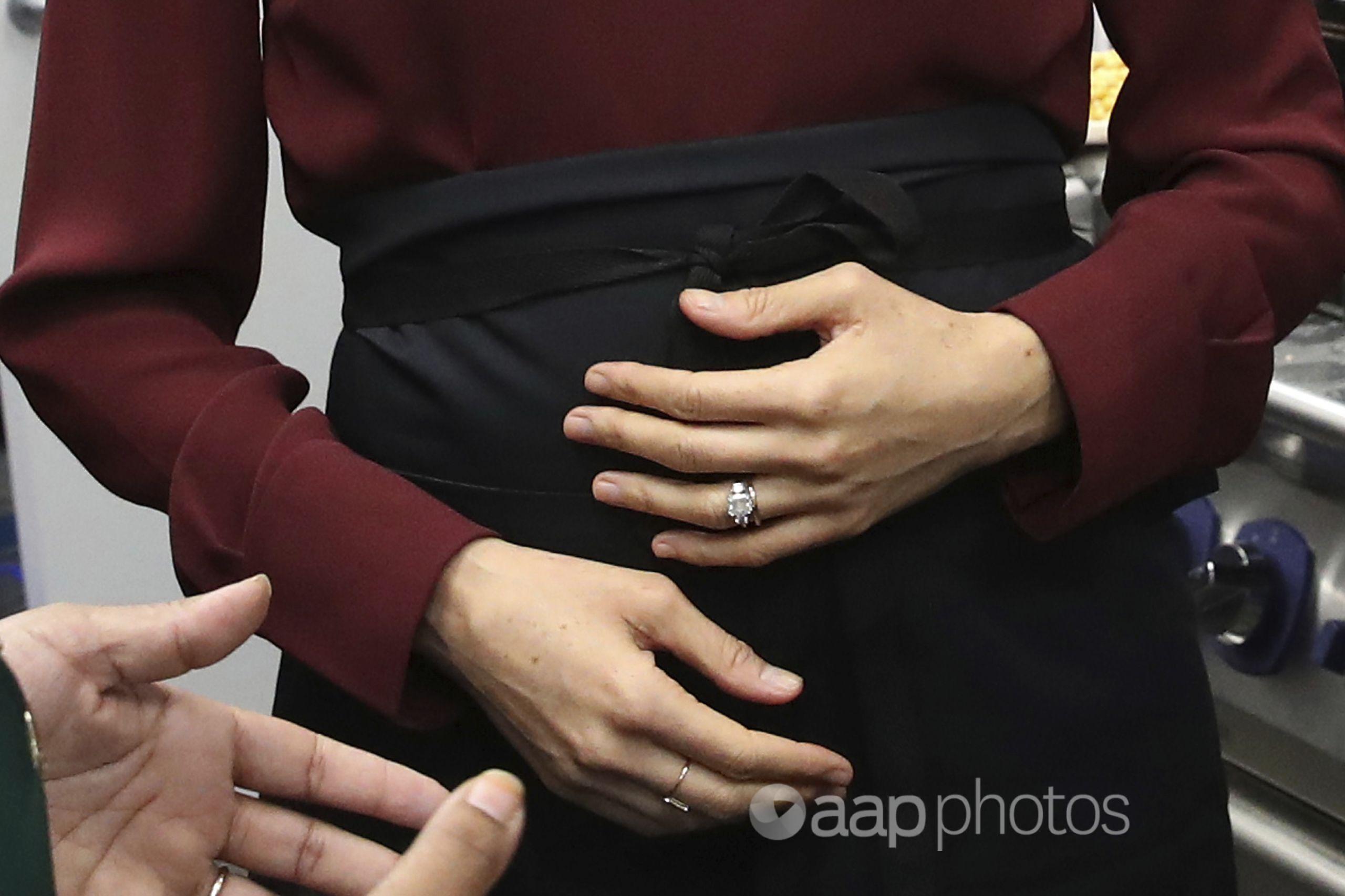The Statement
An Instagram video claims a woman’s health and hormone levels can be indicated by several characteristics of their periods.
The video posted on June 30 is titled, “What your period can tell you about your health & hormones.”
The post’s caption outlines several period “clues” by claiming: “If you see a darker, thicker blood, lots of clots with lots of pain associated, this could mean you have too much estrogen or too little progesterone to balance estrogen out.”
“On the flip side if your bleed is more of a light pink this could mean too little estrogen, or maybe that you’re not eating enough to get a bright red bleed,” it goes on to say.
“If you are seeing a lot of brown blood (spotting) this usually indicates progesterone is low.”
The post also claims extra-painful periods are a result of inflammation. The video post had been viewed more than 1.7 million times and attracted more than 5,700 likes at the time of writing.

The Analysis
Some period characteristics can be caused by the issues listed in the post but the same symptoms can also be the result of a range of factors. The colour of a period is mostly unrelated to a woman’s underlying hormone levels as hormones fluctuate significantly during the menstrual cycle, experts say.
Womens’ periods involve the loss of blood as the lining of the uterus is shed and expelled at the start of the menstrual cycle.
While the characteristics of a period can provide some clues about women’s health, the information in the post was “really simplified” and “may be misleading”, according to Claire Henry, a research fellow in the University of Otago’s Department of Obstetrics, Gynaecology and Women’s Health.
“Abnormal periods such as spotting, heavy clots etc can be caused by a whole range of things, and cannot be attributed to just ‘increased estrogen’ or ‘low progesterone’,” Dr Henry told AAP FactCheck in an email.
Mike Armour, a senior research fellow in women’s health at Western Sydney University and Mathew Leonardi, a gynaecological surgeon at McMaster University in Canada, told AAP FactCheck that estrogen and progesterone levels change significantly over the menstrual cycle.
Estrogen is a hormone that helps regulate a woman’s menstrual cycle, with bodily levels fluctuating from a peak in the middle of the cycle to the lowest concentrations during a period.
Progesterone is a hormone that triggers the uterus lining to thicken to accept an egg from the ovaries during the cycle. If a woman doesn’t become pregnant each cycle, progesterone levels are reduced and this triggers menstruation.
For the claim that lots of spotting means low progesterone, Dr Armour and Dr Leonardi told AAP FactCheck in a joint email: “There are points in the cycle where levels of estrogen and progesterone are high or low, so claims of ‘low’ or ‘high’ levels insinuating there are either stable levels of these hormones over the menstrual cycle are generally not the case.”
Low progesterone levels may be normal at certain points in the menstrual cycle, or they may signify a lack of ovulation – or anovulation – which is abnormal, they explained.
The pair said some women who experience anovulation can have abnormal bleeding in the form of spotting, but the condition was more likely to manifest in the form of infrequent menstrual cycles that can be heavy and prolonged.
“Spotting can happen in people with anovulation but to suggest this is because of low progesterone rather than the root cause (lack of ovulation) is misleading, since people will think they need to find a way to increase their progesterone,” they said.
Dr Henry also said spotting may not be related to a hormonal imbalance, pointing to other potential causes such as pregnancy, STIs, cervical ectopy, polyps or fibroids.
For the claim that dark red, clotty periods mean excess estrogen and light pink periods mean low estrogen, Dr Armour and Dr Leonardi said the colours are more related to the “amount of bleeding and the point in the period phase of the menstrual cycle”.
An article by US academic medical centre the Cleveland Clinic says dark red periods with blood clots generally mean that a woman’s period blood has remained in the uterus for a longer amount of time before it’s shed, causing the blood to clump together and form clots.
Pink-coloured periods sometimes occur at the start of a woman’s cycle when the vaginal mucus discharge mixes with some fresh, bright red blood leading to a period with a pink hue, it adds.
Kelton Tremellen, a gynaecologist and professor of reproductive medicine at Flinders University, told AAP FactCheck that pink periods could be due to low estrogen levels, as claimed in the post, which can result in light or no periods.
However, he also said that women with very low estrogen levels will normally not menstruate as estrogen is responsible for building up the lining in the uterus.
“Like all things medical, you can get exceptions … I do not think you can make a real assessment of the health of a woman from her self-described periods. Just too subjective and too many causes for variation,” Prof Tremellen said via email.
Dr Armour and Dr Leonardi said the claim that extra-painful periods could be a result of inflammation was “somewhat true”, pointing to dysmenorrhea, a condition which causes severe menstrual cramps during a period, which results in inflammation.
“Primary dysmenorrhea occurs mainly due to excess prostaglandins (a pro-inflammatory compound). Secondary dysmenorrhea such as endometriosis also has inflammatory components but is multifactorial, and some of the persistent pain components of endometriosis seem unrelated to inflammation,” the doctors said.
They say there are other conditions which aren’t necessarily period-related but can cause period pain such as adenomyosis, a condition where cells lining the uterus also grow in the layer of muscle in the wall of the uterus, and fibroids, non-cancerous tumours that grow in and around the uterus.
The Verdict
While the period characteristics outlined in the post could be linked to the causes listed, several experts told AAP FactCheck these symptoms can also be a result of numerous other causes.
They also noted that hormone levels naturally fluctuated throughout a woman’s menstrual cycle, as did the colour of period blood. For all of these reasons, the video’s suggestion that period colour was an indicator of hormone levels or overall bodily health is oversimplified and potentially misleading.
Missing Context – Content that may mislead without additional context.
* AAP FactCheck is an accredited member of the International Fact-Checking Network. To keep up with our latest fact checks, follow us on Facebook and Twitter.
All information, text and images included on the AAP Websites is for personal use only and may not be re-written, copied, re-sold or re-distributed, framed, linked, shared onto social media or otherwise used whether for compensation of any kind or not, unless you have the prior written permission of AAP. For more information, please refer to our standard terms and conditions.


















